NEBRASKA MUNICIPAL REVIEW
Seward adds ‘Showcase City’ to list of accolades
Grand Island recognized as hotspot of economic growth
Lincoln announces 911/988 partnership
Official Publication of the League of Nebraska Municipalities
APRIL 2024

Learn more about putting ideas into action with a Creative District. Page 8

 McCook
Ogallala
McCook
Ogallala
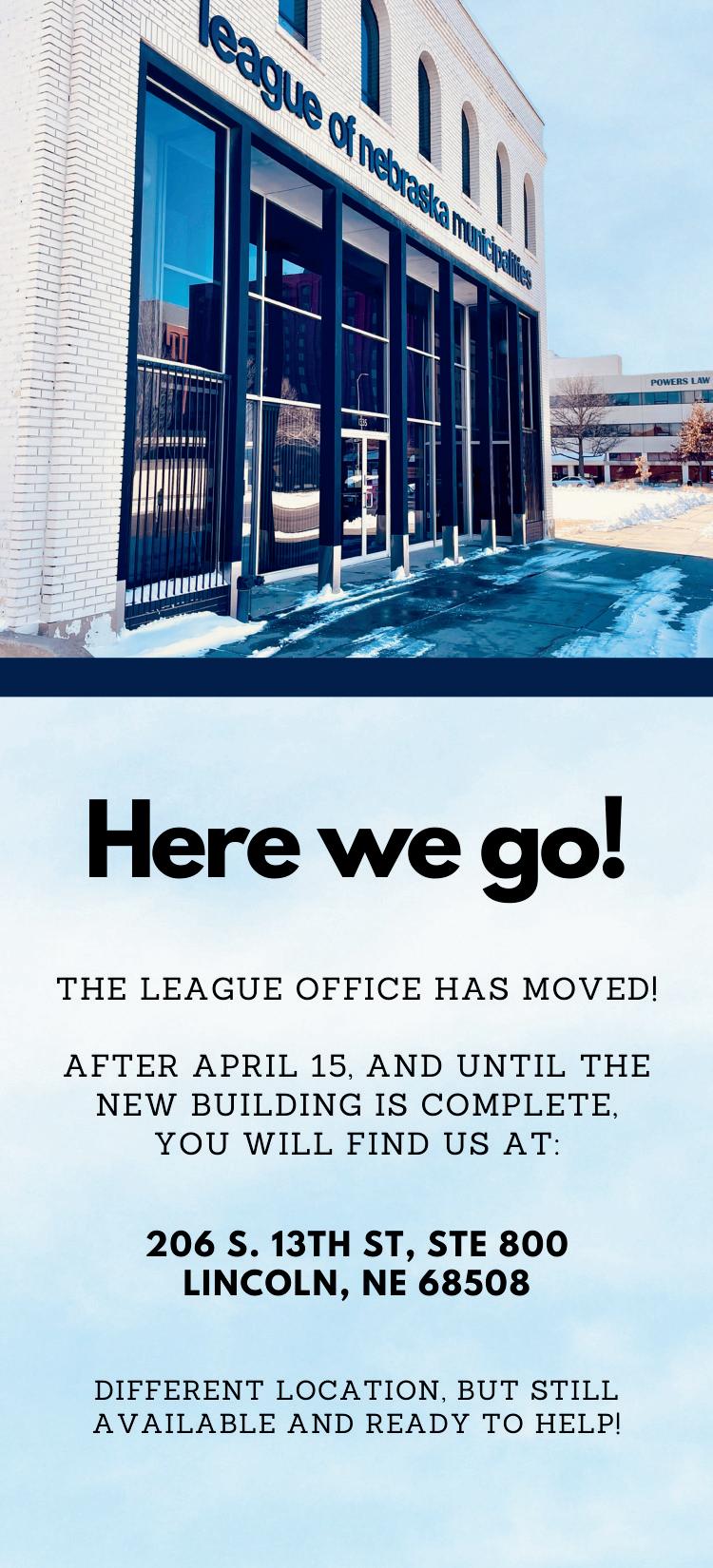
Larger Cities Legislative Committee
Seth Sorensen City Manager, Alliance
Tobias Tempelmeyer City Administrator/General Manager, Beatrice
Rusty Hike, Mayor, Bellevue
Jim Ristow, City Administrator, Bellevue
Mindy Rump, Mayor, Blair
Phil Green, City Administrator, Blair
Desirae Solomon, City Attorney, Blair
Miles Bannon, Council Member, Chadron
Tom Menke, City Manager, Chadron
Jim Bulkley, Mayor, Columbus
Tara Vasicek, City Administrator, Columbus
Dave Bauer, Mayor Crete
Tom Ourada, City Administrator, Crete
Joey Spellerberg, Mayor, Fremont
Jody Sanders, City Administrator, Fremont
Kent Ewing, Mayor, Gering
Laura McAloon, City Administrator, Grand Island
Mike Evans, Mayor, Gretna
Paula Dennison, City Administrator, Gretna
Corey Stutte, Mayor, Hastings
Shawn Metcalf, City Administrator, Hastings
James Liffrig, Mayor, Holdrege
APRIL 2024
Contents
4
6
The Commentary by Senator John Arch (District 14), Speaker of the Legislature –Closing comments from the 2024 Legislative session
Seward adds ‘Showcase City’ to list of accolades
Offering callers what they need – Lincoln announces 911/988 partnership
Creative Districts: Creating vibrant, unique, and creative spaces in our communities
Supreme Court rules in important public official social media case
Grand Island recognized as hotspot of economic growth in national study
USDA RD: Leading the change in clean energy
Ralston bond rating raised 3 levels
LARM – Mitigating police shortages in America
DED accepting applications for grant opportunity within the Site and Building Development Fund
The Legal Corner by Andy Barry, Cline Williams Wright Johnson & Oldfather, L.L.P.Public records in Nebraska
Center for Rural Affairs develops Nebraska Rural Farmers Market Handbook
Ask LNM: Frequently Asked Municipal Questions
Classifieds
Directory
the Cover:
Photos of murals from Creative Districts around the state. All photos shared by Nebraska Arts Council.
Chris Rector, City Administrator, Holdrege
Stan Clouse, Mayor, Kearney
Brenda Jensen, City Manager, Kearney
Doug Kindig, Mayor, La Vista
Pam Buethe, Clerk, La Vista
John Fagot, Mayor, Lexington
Joe Pepplitsch, City Manager, Lexington
Margaret Blatchford, Assistant City Attorney, Lincoln
Amanda Barker, Advisor to the Mayor, Lincoln
Linda Taylor, Mayor, McCook
Nate Schneider, City Manager, McCook
Bryan Bequette, Mayor, Nebraska City
Perry Mader, City Administrator, Nebraska City
Josh Moenning, Mayor, Norfolk
Andrew Colvin, City Administrator, Norfolk
Dani Myers-Noelle, City Attorney, Norfolk
Brandon Kelliher, Mayor, North Platte
Layne Groseth, City Admin./Utilities Manager, North Platte
Steve Krajewski, Mayor, Ogallala
Kevin Wilkins, City Manager, Ogallala
Thomas Warren, Chief of Staff, Omaha
David Black, Mayor, Papillion
Amber Powers, City Administrator, Papillion
Smaller Cities Legislative Committee
Jessica Quady, City Administrator, Ashland
Marlin Seeman, Mayor, Aurora
Eric Melcher, City Administrator, Aurora
Chris Anderson, City Administrator, Central City
Nikki Schwanz City Administrator, Cozad
Andrew Lee, Admin./Clerk/Treasurer, Curtis
Alan Michl, Chairperson, Exeter
Becky Erdkamp, Clerk/Treasurer, Exeter
Kyle Svec, City Administrator, Geneva
Deb VanMatre, Mayor, Gibbon
Matt Smallcomb, City Administrator, Gibbon
Gary Greer, City Administrator, Gothenburg
Douglas Huber, Mayor, Hebron
Jana Tietjen, Clerk, Hebron
Kelly Oelke, City Administrator, Hickman
Janine K. Schmidt, CMC/Treasurer, Morrill
Sandra Schendt, Clerk/Treasurer, Nelson
David Russell, Director of Government Affairs, NMPP Energy
Mandy Hansen, Government Affairs Liason, NMPP Energy
Sandy Kruml, Clerk/Treasurer, Ord
Mike Feeken, Mayor, St. Paul
Nancy Bryan, Clerk/Treasurer, Stromsburg
Sandra Foote, Council Member, Superior
Jeff Hofaker, City Administrator, Sutton
R. Paul Lambert, Mayor, Plattsmouth
Emily Bausch, City Administrator, Plattsmouth
Don Groesser, Mayor, Ralston
Brian Kavanaugh, Council Member, Ralston
Rick Hoppe, City Administrator, Ralston
William De Roos, City Administrator, Schuyler
Jeanne McKerrigan, Mayor, Scottsbluff
Jordan Colwell, Vice Mayor, Scottsbluff
Kevin Spencer, City Manager/Police Chief, Scottsbluff
Joshua Eickmeier, Mayor, Seward
Greg Butcher, City Administrator, Seward
Roger Gallaway, Mayor, Sidney
David Scott, City Manager, Sidney
Carol Schuldt, Council Member, South Sioux City
Lance Hedquist, City Administrator, South Sioux City
Cale Giese, Mayor, Wayne
Jill Brodersen, Council President, Wayne
Wes Blecke, City Administrator, Wayne
Barry Redfern, Mayor, York
Dr. Sue Crawford, City Administrator, York
Jessica Meyer, City Administrator, Syracuse
Kyle Arganbright, Mayor, Valentine
Melissa Harrell, City Administrator, Wahoo
Desiree Soloman, City Attorney, Waterloo
Stephanie Fisher, City Administrator, Waverly
Tom Goulette, City Administrator/Utility Superintendent, West Point
Randy Woldt, Utilities Superintendent, Wisner
Professional
About
15 22 28 31 27 24 30 7 26 8 12 24
1,188 SSN 0028–1906
No.
18
President Deb VanMatre Mayor, Gibbon
President-Elect Marlin Seeman Mayor, Aurora
Vice President Bryan Bequette Mayor, Nebraska City
Past President Paul Lambert Mayor, Plattsmouth
Directors
Jean Stothert Mayor, Omaha
Leirion Gaylor
Baird Mayor, Lincoln
Julie A. Deepe Mayor, Deshler
Catherine-Jo
Mills Village Chair, Ansley
Joey Spellerberg Mayor, Fremont
Jordan Colwell Vice Mayor, Scottsbluff
Josh Moenning Mayor, Norfolk
Sharon Powell Village Board President, Utica
Jeff Hofaker City Administrator, Sutton
Janine K. Schmidt CMC/Treasurer, Morrill
Layne Groseth City Administrator/Utilities Manager, North Platte
Affiliated Sections
City Managers Amber Powers Papillion
Clerks Kellie Crowell Ravenna
Municipal Brandi Kloepping Accounting Cozad & Finance
Fire Chiefs Dennis Thompson North Platte
Utilities Duane Hoffman Oxford
League Staff
L. Lynn Rex Executive Director
Christy Abraham Legal Counsel
Lash Chaffin Utilities Section Director
Cherie DeFreece Administrative Assistant/ Membership Services Assistant
Brenda Henning Membership Services Assistant
Ethan Nguyen LNM/LARM Information Technology Manager
Jackson Sash Utilities Field Representative/ Training Coordinator
Shirley Riley Membership Services Director
Ashley Wolfe Marketing/Communications Director
LARM Staff
Dave Bos Executive Director
Tracy Juranek Assistant Executive Director, Customer Service Specialist
Diane Becker Communications/Marketing Director
Kyla Brockevelt Executive Administrative Assistant
Drew Cook Customer Service Specialist
John Hobbs Loss Control Specialist
James Kelley Loss Control Specialist
Fred Wiebelhaus Loss Control/Claims Manager
Municipal Legal Calendar
JUNE 2024
CITIES OF THE FIRST CLASS
Within 10 working days following meeting or before next meeting (whichever is sooner) ......................................
Clerk to have minutes available for public inspection. (84-1413)
Within 15 days of Passage Clerk publishes ordinances passed. (16-405) As determined by the Mayor and Council Board of Equalization meets. (16-707)
Within 30 days following Council meeting
Within 20 days after end of month ..............
Clerk publishes official proceedings of meetings, including claims. (19-1102)
Treasurer files monthly financial report. (16-318)
* * Clerk must prepare agenda prior to next Council meeting. (84-1411)
CITIES OF THE SECOND CLASS
Within 10 working days following meeting or before next meeting (whichever is sooner)
Clerk to have minutes available for public inspection.
.................................................................................. (84-1413)
Within 15 days of Passage
Within 30 days following Council meeting
Within 20 days after end of month
Clerk publishes or posts ordinances passed. (17-613)
Clerk publishes official proceedings of meeting. (19-1102)
Treasurer files monthly financial report. (17-606)
* * Clerk must prepare agenda prior to next Council .................................................................................. meeting. (84-1411)
Within 10 working days following meeting or before next meeting (whichever is sooner)
Within 15 days of Passage
VILLAGES
Clerk to have minutes available for public inspection. (84-1413)
Clerk publishes or posts ordinances passed. (17-613) Within 30 days following trustees’ meeting ..............................................
Within 20 days after end of month
Clerk publishes official proceedings of meeting, including claims. (19-1102)
Treasurer files monthly financial report. (17-606)
* * Clerk must prepare agenda prior to next Board meeting. (84-1411)
The NEBRASKA MUNICIPAL REVIEW is the official publication of the League of Nebraska Municipalities, an association of the cities and villages of Nebraska, published at 206 S.13th St., Ste. 800, Lincoln, Nebraska 68508 — Telephone 402-476-2829; FAX 402-476-7052; Website: www.lonm.org. Periodicals postage paid at Lincoln, Nebraska. Views of contributors, solicited or unsolicited, are their own and not to be construed as having the endorsement of the League unless specifically and explicitly stated by the publisher The NEBRASKA MUNICIPAL REVIEW is a nonprofit publication administered and supervised by the League of Nebraska Municipalities. All revenue derived from the publication is used by the association to defray publication costs. The NEBRASKA MUNICIPAL REVIEW is published monthly. Subscription rates are $5 per single copy — $50 plus tax for 12 issues. POSTMASTER: Send address changes to NEBRASKA MUNICIPAL REVIEW, 206 S.13th St., Ste. 800, Lincoln, Nebraska 68508. (All statute citations to Revised Statutes of Nebraska)
Nebraska Municipal Review Editor and Advertising Sales: Ashley Wolfe, 402-476-2829 or ashleyw@lonm.org
Executive Board 2023-2024

Good afternoon colleagues. Welcome visitors. The Second Session of the 108th Legislature is coming to a close and I want to thank each of you in this body for your hard work and for the sacrifices you have made this session. We accomplished a lot and we should be proud of the work we have done. There were 597 pieces of legislation introduced this year. Including the bills we passed today and including those bills amended into packages, we have in effect sent over 370 bills to Gov. Pillen for his signature, including A-bills. That number also includes a number of bills introduced and heard last year. Within those pieces of legislation are good-government policies that will grow our economy, our workforce and our communities, strengthen our K-12 education, provide more support for our families, reform our criminal justice system, protect our valuable resources and improve the physical and mental wellbeing of Nebraskans.
I have been asked by many people, what changed between the First Session of the 108th Legislature and this, the Second Session of the 108th Legislature. And the answer is – a lot. I think we can all agree that last session was motivating to all of us to
Closing comments from the 2024 Legislative session
BY SEN. JOHN ARCH (DISTRICT 14), SPEAKER OF THE LEGISLATURE
find a different way to legislate, and also clarifying as to just how important and extremely fragile this treasure of our legislative institution truly is.
In my end of session speech last year, I stated that it would “be up to the members of the Legislature to determine what kind of Legislature we want going forward. A Unicameral that is focused on approaching governance with a solution-focused, problem–solving mindset will only happen if” we want that. I made a commitment to this institution and to the members of this body that I would work with you over the interim to assess what we had learned – lessons both good and bad. And that’s what I did, and that’s what a lot of you did. We successfully hit the reset button!
The interim gave us the opportunity to implement a number of changes to strengthen our institution, which directly impacted this session.
In addition to spending time with our colleagues over the interim, we also conducted an interim study, LR 179, to get feedback from the public regarding its participation in this representative form of government. As we discussed at the Legislative Council meeting in December, the feedback was eye-opening and enlightening. The message was clear:
we, as individual senators, as a body of representatives of this institution, needed to do better.
We made a number of changes including a new easy-to-follow bill tracker on our website, more comprehensive information available to the public, improvements to the online comment portal and a structured committee-hearing process for controversial issues.
We also made a number of changes to our own internal rules of legislative procedure to make the process of debate more efficient. Each amendment to the rules was given a public hearing, input was received and seriously considered, adjustments were made, compromises were made, a transparent and open discussion occurred on the floor, and we ended up with a set of rules which improved the quality of our debate and improved the functioning of our institution.
Certainly there were controversial issues that lead to difficult debate – and there always will be - but we learned how to deal with those issues and find a way to debate them productively.
We improved our communication to each other. If there was opposition to a bill, you attempted to understand
4 NEBRASKA MUNICIPAL REVIEW
THE COMMENTARY
the opposition’s concerns and find a path forward, ultimately resulting in a better bill. We learned to work together and compromises were made to improve the legislation. I think that was obvious by how many bills we passed with such broad support. We took the 60-day opportunity to define ourselves as a solution-focused, problem-solving Legislature and for that, Nebraskans will benefit.
For those of us continuing on to become members of the 109th Legislature, we must hold on to the lessons that we have learned and carry those forward so we can be good role models for those who will join us. We must continue to protect this unique treasure, this gem, this institution of the Unicameral.
For those who will not be back next year – thank you. Thank you for sharing your wisdom, thank you for your service, and thank you for the sacrifices you made. Senator Albrecht, Senator Blood, Senator Bostelman, Senator Brewer, Senator Erdman, Senator Halloran, Senator Linehan, Senator Lowe, Senator McDonnell, Senator Meyer, Senator Slama, Senator Vargas, Senator Walz, Senator Wayne, and Senator Wishart – thank you and it was a pleasure serving with you all.
As we know, this Legislature embodies more than just 49 senators and there are many, many dedicated people behind the scenes, who without them, this Legislature simply wouldn’t function. As I say your name, could you please stand up.
First, I would like to thank and recognize our Clerk of the Legislature, Brandon Metzler. Without Brandon, I think we would all be lost. Brandon, you did an outstanding job in your first two years of your tenure as Clerk, and your advice to me on rules and procedures was extremely valuable.
Next, Assistant Clerk Dick Brown – Thank you Dick for your decades of service and for your willingness to stay and support the Clerk in his first two years. Also, Deputy Director of Committee Support Mike Hybl and the Clerk’s staff who are on the floor each day – Carol Koranda, Jenni Svehla, and Diane Johnson. And the rest of the Clerk’s immediate office, who are here every night after we adjourn and here first thing in the morning.
Our legislative pages, who are supervised by Kate Kissane and Bobby Busk
The Clerk’s support offices which include: our Bill Room and Mail Room, our Transcribers, our Unicameral Information Office, our Legislative Technology Office, and
of course, our Sergeant at Arms.
I want to take a moment and recognize some of our sergeants who will be retiring: Gerry Van Ackeren and Laurie Klosterboer – both have been helping keep us in line since 2020. And of course, our Chief Sergeant at Arms Burdette Burkhart who has been with this Legislature since 2015. Thank you all for your service and enjoy your retirement.
Our Legislative Fiscal Office with director Keisha Patent and the Revisor’s Office with Revisor of Statutes Marcia McClurg.
It would be an understatement to say we kept these two offices a little busy this year and a little overwhelmed.
In addition to the over 500 bills and resolutions introduced at the beginning of the session, Senators requested over 1400 amendments, with 740 fiscal notes. These requests required both offices to work late into the evenings, on weekends and on holidays. Thank you all for your hard work.
Our Legislative Research Division, led by Ben Thompson.
The Legislature’s Accounting and Budget Office, led by Shelley Reed.
Our Performance Audit Division, supervised by Auditor Stephanie Meese.
Our Inspector General of Corrections, Doug Koebernick and our Inspector General of Child Welfare, Jennifer Carter.
Our Ombudsman’s Office led by Ombudsman Julie Rogers.
Our President and Presiding Officer, Lieutenant Governor Joe Kelly.
And of course all our committee staff and personal staff. Including my own team, Laurie Weber, Lisa Johns and Mandy Mizerski.
I also want to thank Nebraska Public Media for its coverage of the Legislature, bringing state government into the homes of people across the entire state.
And finally, last but not least, Captain Mike Grummert, Lieutenant Sean Wilson, and Trooper Dusty Black and the rest of the Nebraska State Patrol and of course our own Capitol Security team. Your support and efforts to keep us safe and maintain order are appreciated.
Thank you again to everyone for your hard work and for a session we can all be proud of.
5 APRIL 2024
Seward adds ‘Showcase City’ to list of accolades

 BY EMILY HEMPHILL SEWARD COUNTY INDEPENDENT
BY EMILY HEMPHILL SEWARD COUNTY INDEPENDENT
Nebraska Gov. Jim Pillen presented Seward with the 2024 Nebraska Showcase Community of the Year award at an April 2 ceremony at the Nebraska National Guard Museum.
The distinction was made on behalf of the Nebraska Department of Economic Development (NDED) in recognition of the community’s growth and achievements over the last five years.
“A day like today is so much fun from my seat because this didn’t happen yesterday. It didn’t happen today. There’s extraordinary people in the community of Seward, and it’s been going on for generations,” Pillen said.
He reflected on his past time spent in Seward, when his father-in-law, the late Marvin Shreve, was Superintendent of Seward Public Schools from 1975-1993.
Continued on page 20 / See Seward
Most see a trail. We see a chance to explore nature.
ENGINEERING POSSIBILITIES.

6 NEBRASKA MUNICIPAL REVIEW
olsson.com
Seward is named the 2024 Nebraska Showcase Community of the Year April 2 at the Nebraska National Guard Museum. Pictured are (from left) Maj. Gen. Craig W. Strong, Adjutant General of the Nebraska National Guard; Joshua Eickmeier, Mayor of the City of Seward; Jim Pillen, Governor of Nebraska; and Jonathan Jank, President and CEO of the Seward County Chamber and Development Partnership. Photo provided by Emily Hemphill/Seward County Independent
Mayor Leirion
Gaylor Baird, with communications and mental health officials, said a new partnership between the Lincoln Emergency Communications Center (LECC) and the 988 Suicide & Crisis Lifeline represents a significant step forward in crisis response and underscores the City's commitment to prioritizing mental health. Lincoln is the first city in Nebraska to establish the 911/988 partnership.
need Offering callers what they need
Offering callers what
they
“This new partnership reflects the priority we place on mental health and ensures that anyone in our community who needs a lifeline gets one. Thanks to the work of our public safety professionals and state and community partners, that lifeline is now just a phone call away,” Mayor Gaylor Baird said. This innovative partnership empowers 911 telecommunicators to connect individuals in suicidal crisis or emotional distress directly to licensed crisis counselors at the 988 Lifeline. With this system in place, callers in need of immediate mental health support can access trained professionals without necessitating law enforcement intervention. Previously, LPD officers were dispatched to all calls regarding callers in mental health crisis. LPD officers will continue to be available to respond if immediate law enforcement intervention is necessary.
The 988 Lifeline is a free, confidential service provided through a national network of more than 200 crisis centers. Calls to 988 are routed to the nearest center based on the caller’s area code. In addition to handling calls, the centers offer

resources such as text, chat, mobile services, training and educational resources on suicide prevention and mental wellness.
Joining Mayor Gaylor Baird at the news conference were Jessica Loos, 911 Communications Coordinator; Kyle Kinney, 988 Nebraska Suicide and Crisis Lifeline Program Manager; and Dr. Steve Corsi, Chief Executive Officer for the Nebraska Department of Health and Human Services.
City of Lincoln pilots new collaboration to enhance mental health crisis response
Lincoln’s 911/988 partnership is the first in Nebraska

Loos said that over the last six months of 2023, the LECC received nearly 6,000 mental health crisis calls that could have been assessed for possible transfer to a 988 counselor. Because the 911/988 collaboration expands the ability of emergency dispatchers to assign personnel more efficiently, she said, it further strengthens the confidence the community has in its 911 emergency communications service.
Continued on page 17 / See 911
7 APRIL 2024
Photo provided by 911 Communications Center
Kyle Kinney, 988 Nebraska Suicide and Crisis Lifeline Program Manager; Jessica Loos, 911 Communications Coordinator; Lincoln Mayor Leirion Gaylor Baird; and Dr. Steve Corsi, Chief Executive Officer for the Nebraska Department of Health and Human Services, attended the press conference announcing the 911/988 partnership. Photo provided by City of Lincoln
&

DISTRICTS:
vibrant, creative, Creating spaces in OUR communities unique,
BY RACHEL MORGAN, PROGRAM SPECIALIST, NEBRASKA ARTS COUNCIL
The Nebraska Creative Districts (NCD) program establishes what we all knew to be intrinsically true, that people want to live in and visit vibrant, creative, unique communities. The Creative District program at the Nebraska Arts Council enables communities in Nebraska to take advantage of that fact.
With legislation passed in 2020 to create the program, it has grown by leaps and bounds over the last few years. At the time of this article, Nebraska currently has 29 officially certified districts, with 20 more working through the process.
The program is designed to be flexible enough for both urban and rural communities. Communities are able to create a district that fits their identity and how they use the space.
The process of being certified includes the community doing a strengths, weaknesses, opportunities,
NEBRASKA MUNICIPAL REVIEW
8 NEBRASKA MUNICIPAL REVIEW
Haymaker District in Cozad: Chamber Director Jordan Starman, Mayor Marcus Kloepping, Creative District Coordinator Karlie Buss. Photo provided by Nebraska Arts Council
CREATIVE

and threats (SWOT) analysis, asset mapping, and strategic planning. The thorough planning process allows the communities to design projects that fit their communities best.
The benefits to the communities have shown to be substantial so far, even this early into the program. Brownville, who has a recorded population of 142, has seen two new businesses open in the past year,

both of them art studios and galleries. That, along with the opening of the Brownville Education Center for Arts and Humanities (BECAH) has reinvigorated the community and are putting them on the map as a creative center. The Haymaker District in Cozad is also seeing growth in its business district, with two new coffee shops, a candy store, a wholistic health spa, and a new brewery. One of the most exciting developments is a new 5,000-square-foot art gallery addition to the Robert Henri Museum.
“You can hit the ground running and just move forward with those projects knowing that you have the money already in your bank account,” Steve Woerth, director of the Brownville Creative District, said. The grant programs associated with the creative district include a Certification Grant of $10,000 and a Development Grant of up to $100,000. Both grant programs
9 APRIL 2024
Benson Creative District: Benson Creative District Ribbon Cutting. Photo provided by Nebraska Arts Council
Continued on page 10 / See Arts Fremont Creative District: Fremont Creative District Hispanic Festival. Photo provided by Nebraska Arts Council

Art
Continued from page 9
are available to districts after they have become officially certified. Currently, neither grant program requires a match. “You don’t have to actually go out and raise all that money ahead of time. From that standpoint, their grant program is unique and totally suited for the small communities that the Creative District is built around,” Woerth states.
Districts also can use grant funds to help support events and programs in their community that will bring in visitors. The Benson Creative District (BCD) in Omaha reports “We have witnessed a growth in interest and involvement in Benson’s creative community - both from pre-existing stakeholders, new stakeholders, and external organizations and individuals. Other changes we have seen are an increase in attendance at First Fridays, new partnerships being built including with the City of Omaha, and a great interest in the BCD [Benson Creative District] from local artists.”
One of the mainstays of the Creative Districts program is partnerships. “By bringing people together, communities are selecting projects that are important to those that live there,” Rachel Morgan, Program Specialist at the Nebraska Arts Council, said. The Fremont Creative District reported one unexpected benefit of becoming a certified creative district has been the coordination of projects and ideas. Prior to certification, several area businesses and organizations were working or dreaming individually on ideas. Pursuing the Creative District certification has allowed them to coordinate with the city’s Planning Department, Parks and Recreation team, Business Improvement District, and property owners.
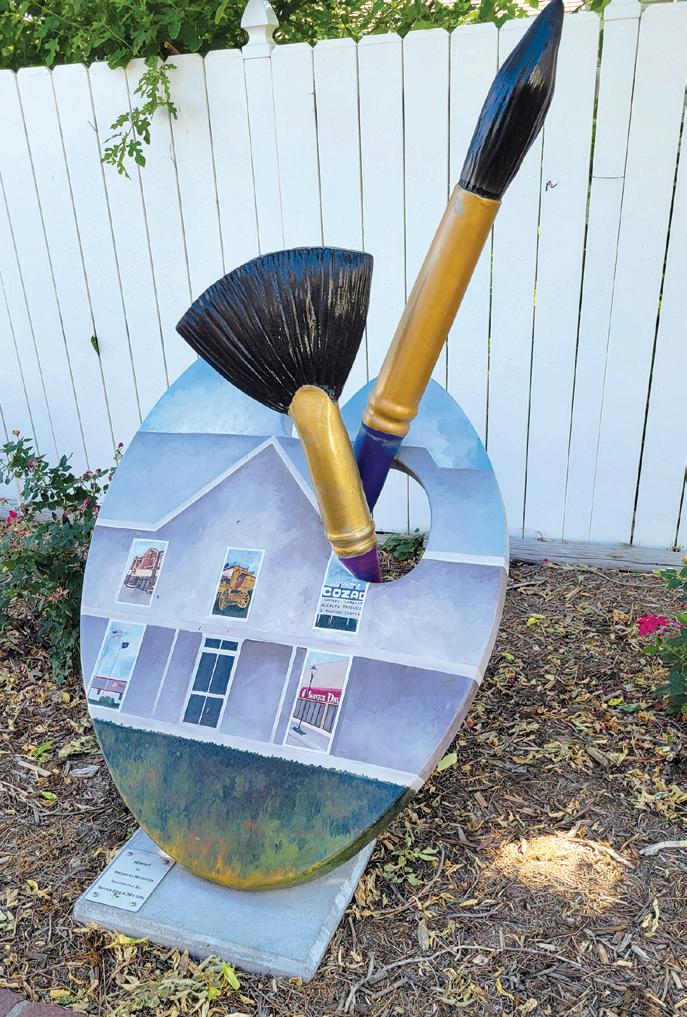
Learn more
For more information about the Nebraska Creative District program visit:
https://www.artscouncil.nebraska.gov/ explore/creative-districts/
or contact Rachel Morgan, Program Specialist.
10 NEBRASKA MUNICIPAL REVIEW
Columbus Creative District: Frankfort Square Mural. Photo provided by Nebraska Arts Council
Haymaker District in Cozad: Pallette and brush public art outside Robert Henri Museum. Photo provided by Nebraska Arts Council

The League Insurance Government Health Team (LIGHT) helps hundreds of its members throughout Nebraska obtain affordable health insurance coverage. RECEIVE DEDUCTIBLE AND OUT-OF-POCKET CREDIT FROM YOUR CURRENT VALID GROUP PLAN WHEN YOU SWITCH!
Plan and Network Choices
With seven plan options and three networks to choose from, you’re sure to find one that meets your group’s coverage and benefit needs.
Affordable Plan Options
Offering your employees much-needed protection against the high cost of medical care:
• Three PPO options
• Four HSA-eligible high deductible options
• Prescription drug coverage
Enrollment Options
Single: Covers the employee only
Employee and spouse: Covers the employee and their spouse
Employee and children: Covers the employee and their eligible dependent children, but does not provide coverage for the spouse
Family: Covers the employee and eligible dependents including a spouse
Available Network Options
With several networks available, you have easy access to quality providers:
• NEtwork BLUE (Statewide)
• Premier Select BlueChoice (Regional)
• Blueprint Health (Regional)
• Out-of-state network availability
LET’S GET STARTED
11 APRIL 2024
Blue Cross and Blue Shield of Nebraska is an Independent Licensee of the Blue Cross and Blue Shield Association. 60-025-58 (01-17-23)
Contact
Agent/Broker Or contact Dennis Maggart Executive Vice President P: 913-378-9841 or 816-718-0335 Dennis@McInnesGroup.com Jane Limbach Account Man ager P: 913-378-9840 Jane@McInnesGroup.com GET A
your current local
QUOTE AND JOIN TODAY!
Supreme Court rules in important public official social media case
BY AMANDA KARRAS EXECUTIVE DIRECTOR, INTERNATIONAL MUNICIPAL LAWYERS ASSOCIATION
The International Municipal Lawyers Association (IMLA) is a non-profit, professional organization that has been an advocate and resource for local government attorneys since 1935. Amanda Karras is the Executive Director/General Counsel of IMLA and oversees IMLA’s legal advocacy efforts with the U.S. Supreme Court, Circuit Courts, and state appellate courts. What follows is Ms. Karras’ summary of a recent U.S. Supreme Court decision regarding local government officials and social media.
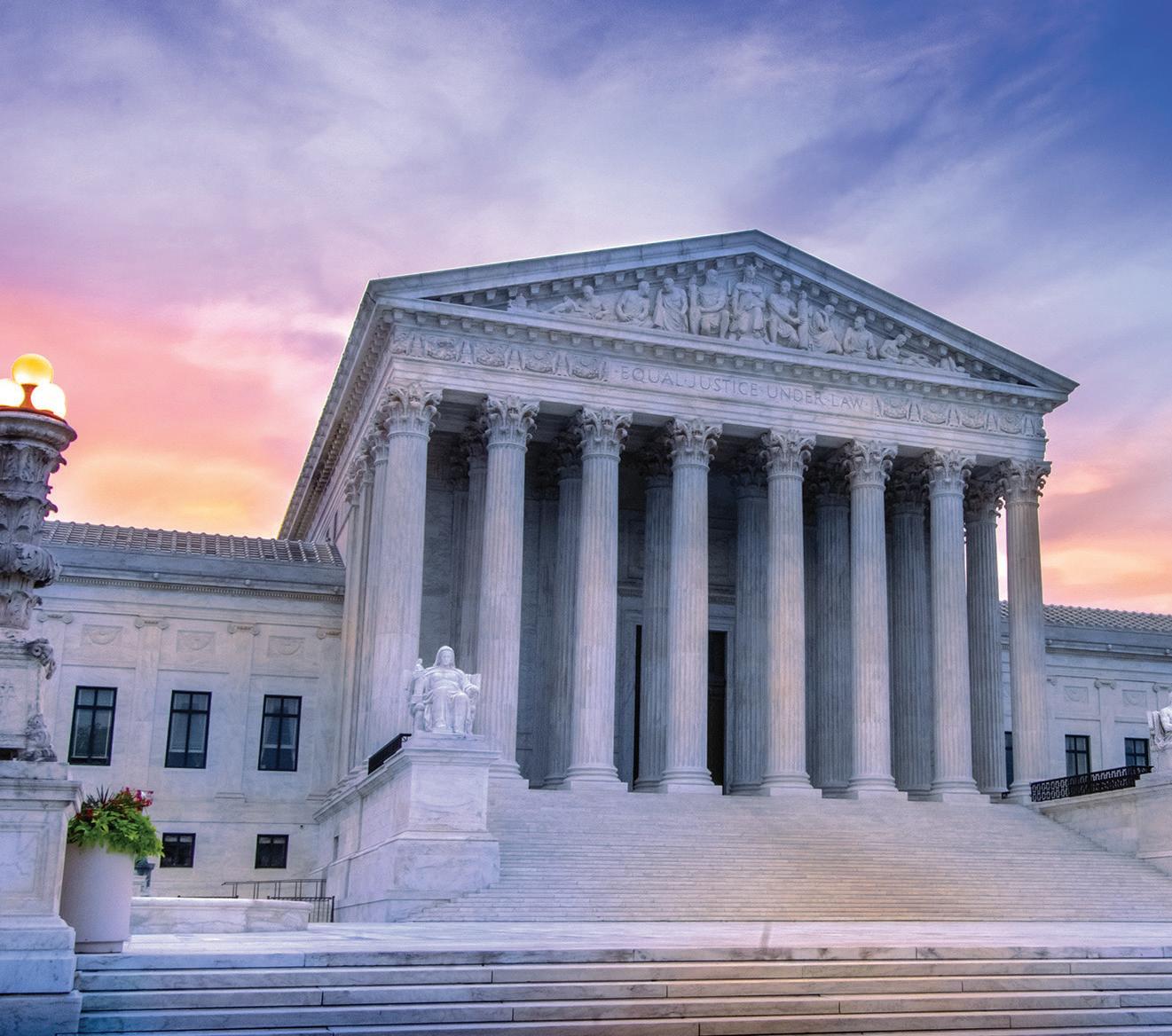
You may have already seen various public officials tweeting about this, but on March 15, in Lindke v. Freed, the Supreme Court set forth the test for when local government officials are considered “state actors” for the purposes of the First Amendment when they post on social media. The case is a win for local governments as the test provided by the Supreme Court safeguards the free speech rights of elected officials while balancing the rights of their citizens. More importantly, it is objective and focuses on authority as the test to determine if the official is acting “under the color of state law.” As Justice Barrett put it in writing for the unanimous Court: “To misuse power…one must possess it in the first place.”
In this case, Mr. Freed operated a Facebook page, which he started in college in 2008. At some point, he attracted more than 5,000 friends and under Facebooks rules, he was required to convert the account to a public “page” which allows for unlimited followers. He was required to pick a category for the page, and he picked “public figure.” In 2014, he was appointed the city manager of Port Huron, Michigan and he added that information to his Facebook page. He listed his contact information as Port Huron’s, including linking to the city website, city email, etc. He posted primarily about personal matters including posting pictures of his family, his dog, and food he likes to eat. He also would post information about his job, including the
town’s COVID-19 policies and articles on public-health measures as the pandemic continued.
Mr. Lindke was a citizen of Port Huron and unhappy with the city’s COVID policies. Mr. Lindke would post negative comments on Mr. Freed’s Facebook page and Mr. Freed initially deleted those comments, but then eventually blocked Mr. Lindke from the page.
Mr. Lindke sued, claiming blocking him from the Facebook page was “state action” for the purposes of a Section 1983 claim and that Mr. Freed had violated his First Amendment rights in doing so. Mr. Freed argued his account was strictly personal and not subject to the constraints of the First Amendment. The Sixth Circuit found in favor of Mr. Freed, concluding the proper test to determine if the government official is engaging in state action is to ask whether he was “performing an actual or apparent duty of his office or if he could not have behaved as he did without the authority of his office.” The lower courts were split on the proper test and the Ninth Circuit in a separate case involving the same question had held that state action applies to public officials’ social media accounts based on the “appearance and content” of the pages.
The Supreme Court took the case to resolve the split and provide the test to determine when the First Amendment applies to a government official’s social media account. In a unanimous decision authored by Justice Barrett, the
12 NEBRASKA MUNICIPAL REVIEW
U.S. Supreme Court
Adobe Stock Photo
Supreme Court rejected the Ninth Circuit’s subjective “appearance and content” test and concluded that a government official’s social media posts are “attributable to the state only if the official (1) possessed actual authority to speak on the state’s behalf, and (2) purported to exercise that authority when he spoke on social media.” The Court noted that the “appearance and function of the social-media activity are relevant at the second step, but they cannot make up for a lack of state authority at the first.” The authority must be “real, not a mirage.” The analysis will hinge on substance and not the mere label of public official and the Court explains, it will require a fact-intensive inquiry.
The Court notes that the line between private and state action can be “difficult to draw.” The difficulty is magnified, the Court explains, because of the nature of some public officials’ work, which can make it seem like “they are always on the clock.” But the Court emphasized that public officials have their own First Amendment rights, including rights to speak about their employment, that they do not relinquish simply by becoming public officials. The burden is on the plaintiff to show the official is “purporting to exercise state authority in specific posts.” Additional factors, such as the use of governmental staff and resources may help demonstrate the use of that authority.
The Court explains that its test is derived from the text of
Section 1983, which provides a cause of action where “[e] very person who, under color of any statute, ordinance, regulation, custom, or usage, of any State deprives someone of a federal constitutional or statutory right.” (internal quotations omitted). Thus, a public official has the authority to speak on behalf of the government if based on a written law, regulation, or ordinance which authorizes that person to make official announcements or if there was a well-established custom such that the “power to do so has become permanent and well settled.” (internal quotations omitted). The Court notes in situations where an account belongs to the government or is passed down to the occupier of the particular office, those would be government accounts subject to the First Amendment.
The Court admonished lower courts not to rely on “excessively broad job descriptions” to conclude that authority to speak on behalf of the government exists. The question should be “whether making official announcements is actually part of the job that the State entrusted the official to do.”
The Court provided hypotheticals, which may prove instructive. It explained that in cases where someone has the authority to communicate with their residents,
Continued on page 14 / See Court

Over $950 million back to Nebraska. Must be 19. Free problem gambling help for Nebraskans at problemgambling.nebraska.gov. nelottery.com
Continued from page 13
for state action to exist and First Amendment liability to attach, “there must be a tie between the official’s authority and the gravamen of the plaintiff’s complaint.”
For example, if Mr. Freed had no authority over public health and he was posting about local restaurants with health-code violations and deleted unwanted comments on those posts, he would not be acting with any state authority and would not violate the First Amendment. More obviously, if a mayor posts something expressly invoking the authority of the City or State, the action takes immediate legal effect, and is not otherwise available elsewhere, that post would likely be state action according to the Court. On the other hand, if the official is merely sharing information that is otherwise publicly available, it is far less likely to be state action.
Public officials may use labels and disclaimers on their social media pages such as “this is the personal page” of the individual or “the views expressed are strictly my own” which, according to the Court would entitle the official to “a heavy (though not irrebuttable) presumption that all of the posts on his page were personal.” However, the Court noted such a disclaimer cannot provide cover to conduct government business on a personal page such as by live streaming a council meeting only on that “personal” page.
Because Mr. Freed’s page did not have a disclaimer and his page was used for a variety of things including both private and those related to his job, a fact-intensive inquiry is necessary to determine if when he deleted comments or blocked Mr. Lindke, he was engaged in state action. The Court also notes that lower courts will need to examine both activities that he engaged in on the social media account: deleting and blocking. The
Court cautions that because blocking is a blunt instrument, when an official is using social media in a mixed way, as Mr. Freed did, there is a greater potential to expose themselves to liability as the court must analyze the entire social media page. Deleting on the other hand, is more precise and the only relevant inquiry for First Amendment purposes pertains to those posts for which the comments were deleted.
Because the test the Court issued was new, the Court vacated the judgment of the Sixth Circuit and remanded the case for consideration in light of its opinion. The Court granted certiorari in two cases involving this issue, but its decision in Lindke is the controlling decision. The other decision, O’Connor-Ratcliff v. Garnier resulted in a per curiam short decision vacating the Ninth Circuit’s judgment and remanding the case to consider in light of the new test adopted by the Court.
The Local Government Legal Center filed an amicus brief (joined by IMLA, NACo, and NLC) advocating for a clear and easy to apply state action test focused on authority.
The brief, which was authored by Caroline Mackie & Robert Hagemann of Poyner Spruill also highlighted the unworkable nature of the subjectively driven appearance test and urged the Court to reject that test. And the brief argued that public officials have their own First Amendment rights, which could be squelched if the Court adopts too broad of a test.
As the Court notes, there are millions of state and local government employees in this country with a wide variety of jobs and many of them use social media and will therefore be impacted by this decision. This decision will hopefully bring them some clarity in this area.
To read the decision, click here; https://www.supremecourt. gov/opinions/23pdf/22-611_ap6c.pdf


14 NEBRASKA MUNICIPAL REVIEW
Court Read additional coverage on this important topic from NLC.
Want to know more? “Supreme Court Issues Important Decision Impacting Elected Officials and Use of Social Media”
https://bit.ly/3VAuT1s
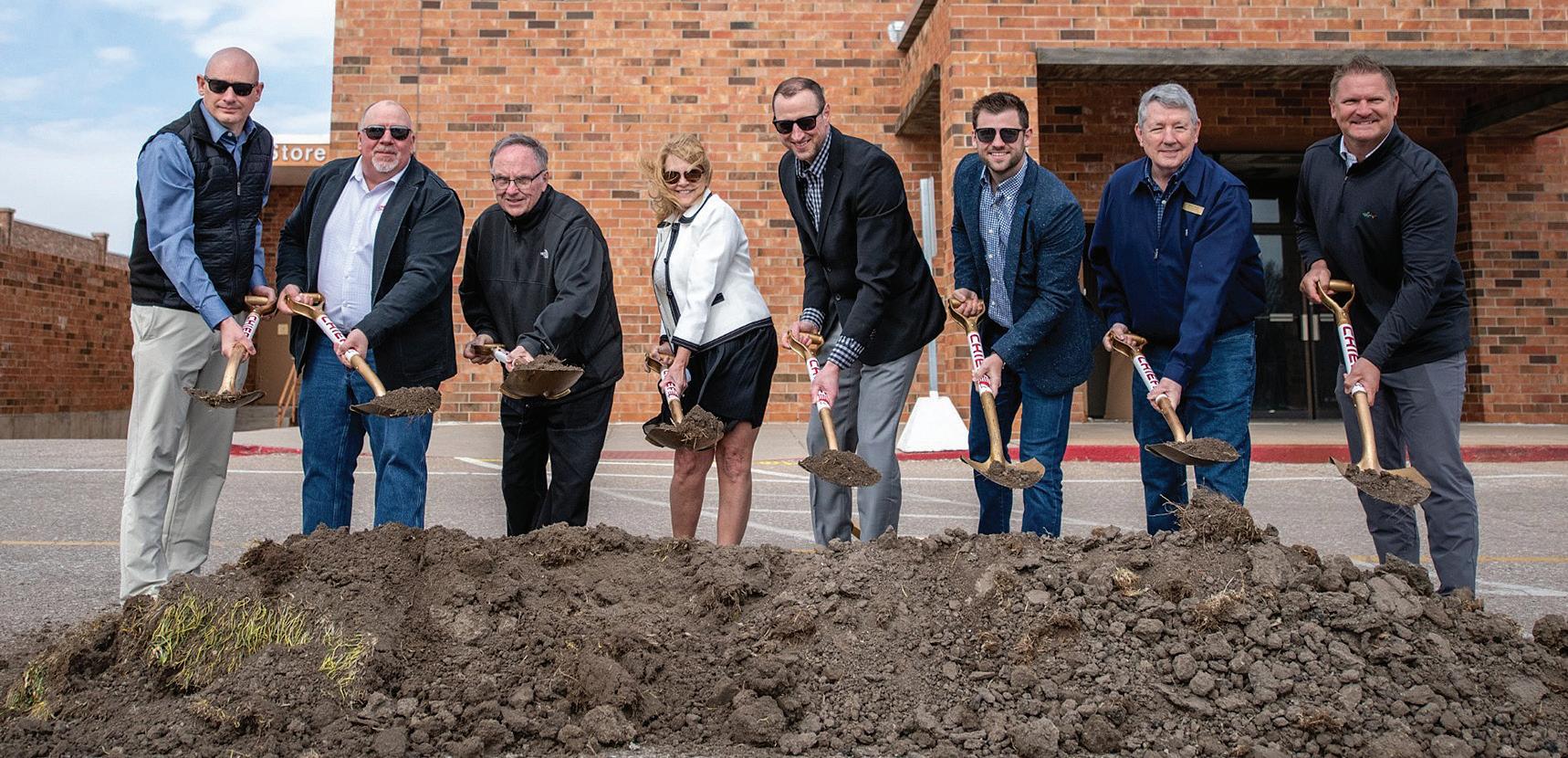
Grand
Island recognized as hotspot of economic growth in national study
BY ASHLEY WOLFE, MARKETING & COMMUNICATIONS DIRECTOR, LNM
Those recognized are poised for long-term growth and often hubs of high-tech industry, where workers may benefit from an afforable cost-of-living
The City of Grand Island is a changing place, with lots of hope for the future—citizens and those doing the on-the-ground work already know this. But recognition in a national study shined a bright spotlight on the economic resilience and strategic development initiatives underway in the community.
Grand Island was recently recognized as the highest-ranked metro area in Nebraska for economic growth in 2023 by the Area Development Leading Metro Locations study. The city was ranked 22nd overall, along with ranking #3 for core economic indicators, #11 for economic strength, and #30 for wage and salary growth out of 384 metros in the United States.
“What’s the best indicator that a city or metropolitan area is healthy from an economic perspective? There are plenty of factors and indicators to examine, but arguably the best general measure of health can be boiled down to one magic word: growth.”
- Area Development Magazine
“Our success underscores the pivotal role of strategic business location in fostering growth, said Grand Island Area Economic Development Corporation President Mary Berlie. “Every square foot of our city resonates with opportunity. The remarkable growth of businesses and GDP has been instrumental in fueling our success, driving innovation, creating jobs, and attracting investment.”
Overall


APRIL 2024
Continued on page 16 / See Grand Island
rankings Grand Island
ranked: #3 #11 #30 1. Salt Lake City, UT 2. Olympia-Lacey-Tumwater, WA 3. Decatur, AL 4. Miami-Fort Lauderdale-Pompano Beach, FL 5. Austin-Round Rock-Georgetown, TX 6. Missoula, MT 7. Palm Bay-Melbourne-Titusville, FL 8. Tampa-St. Petersburg-Clearwater, FL 9. Tallahassee, FL 10. Ogden-Clearfield, UT 11. Naples-Marco Island, FL 12. Crestview-Fort Walton Beach-Destin, FL 13. The Villages, FL 14. Jonesboro, AR 15. Denver-Aurora-Lakewood, CO 16. Boulder, CO 17. Brownsville-Harlingen, TX 18. Chattanooga, TN-GA 19. Gainesville, GA 20. Nashville-Davidson-Murfreesboro-Franklin, TN 21. Rapid City, SD 22 Grand Island, NE 23. Port St. Lucie, FL 24. Colorado Springs, CO 25. Boise City, ID for core economic indicators for economic strength for wage and salary growth
also
15
Eight people took part in the Conestoga Marketplace groundbreaking ceremony in April of 2023. From the left are Grand Island City Councilman Jack Sheard, Roger Bullington of Chief Industries, local developer Ray O'Connor, former Grand Island Chamber of Commerce Director Cindy Johnson, Drew Snyder and Mitch Hohlen of Woodsonia, City Councilman Chuck Haase and Chad Micek of Chief Industries. Photo provided by City of Grand Island
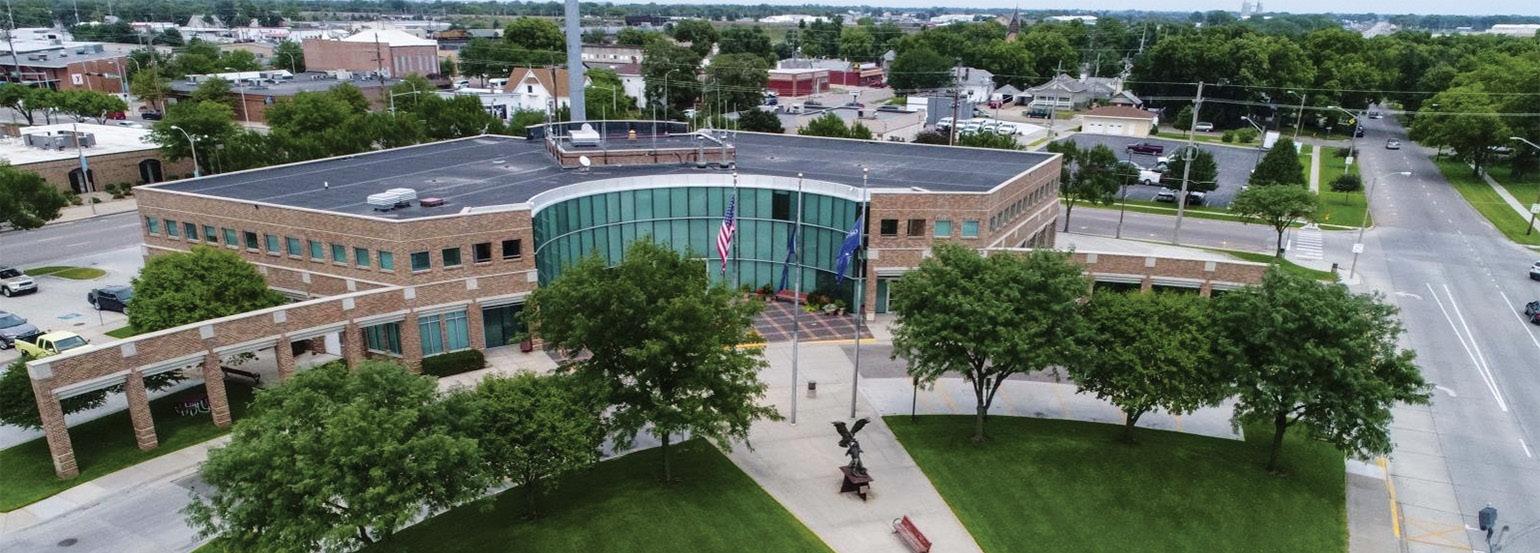
Grand Island
Continued from page 15
Some community improvement projects underway in Grand Island include:
• Conestoga Marketplace;
• Prairie Commons and other major investments along Highways 81 and 34;
• Casino Resort at Fonner Park;
• The Railside Business Improvement District;
• New housing development; and
• Plans for new recreational attractions near I-80.
“Grand Island wouldn’t be the thriving community it is without our community organizations,” said Grand Island Mayor Roger Steele. “Our relationships with these various groups help us not only with growth and community development, but it helps us put our best foot forward for prospective businesses who may be looking to call Grand Island home.”
Grand Island’s population is significantly younger compared to the rest of the state and nation. The community has a median age around 35 — and more than 28% of the population is under 18 (compared to 22.5% nationwide).
According to Jamie Karl, President of the Grand Island Chamber of Commerce, the road forward is one paved with intentionality and continuing to create a place with a future for young people.
“These young residents are our future talent and business leaders, as well as our future Chamber partners,” Karl said. “They must know they are wanted here, needed here, and have an unparalleled quality of life in Grand Island. This is how we ensure continued growth.”
The economic growth in Grand Island is not happening in a vacuum though. The City of Grand Island takes pride in the strategic and intentional community engagement happening in the area. There is a strong collaboration between private
businesses, community organizations and the City of Grand which has created a supportive environment that encourages entrepreneurship and growth of a flourishing business community.
The City of Grand regularly partners with several community organizations including Grow Grand Island, the Grand Island Area Economic Development Corporation, the Grand Island Area Chamber of Commerce and Grand Island Tourism. Currently the city is teaming up with the Chamber on an essay contest for local 6th graders to write about what their vision is for the City by the time they graduate high school. The winning essay gets to be ‘Mayor for a Day.’
Additionally, the city also is teaming up with the Grand Island Welcoming Initiative, which is helping create welcome packets for non-English speaking residents who are moving to Grand Island.
Grand Island has a very diverse population and in recent year there has been a concerted effort put forth to build a welcoming community for people of all backgrounds.
Currently in the works is a 4th Street Business Improvement District plan that will slowly but surely overhaul the 4th Street area with renovations, updates, and improvements. This is a part of the city that is home to a large contingency of the Hispanic population within the city.
The city is also launching a new series titled “The Business Beat” on GITV starting April 1, which features GIPD Chief Kevin Denney visiting local businesses throughout town and tying it back to the police department at the end regarding how can GIPD better serve their business/area in town. The first season of the series focuses solely on businesses that are ethnically diverse, with the first episode being Tacos Los Hermanos on 4th Street.
16 NEBRASKA MUNICIPAL REVIEW
Aerial view of Grand Island City Hall. Photo provided by City of Grand Island

For more information on the 988 Suicide & Crisis Lifeline, visit 988lifeline.org. Learn more
Continued from page 7
“It remains our priority that community members who call 911 trust it will connect them to the right resource in their time of need. Through this partnership, we are able to recognize the critical role 988 plays in responding to mental health crises,” Loos said.
Kinney said that since the 988 Lifeline became available in Nebraska in 2022, the service has received 42,000 calls. Counselors have been able to de-escalate crisis situations for 97% of the callers, he said, and avoid unnecessary interaction with law enforcement or emergency medical services. “Callers reach our crisis counselors and find folks who will work to understand the crisis, assess the safety risks, explore options for safety, and develop a plan. These counselors will help them navigate through resources and follow up to make sure their needs have been met. We want each and every caller to feel like they have the help they need,” Kinney said.
Over 49 million homeowners will put themselves at risk this year by not contacting 811 before digging.*
Whether you’re an excavator or a facility operator, keep yourself and those around you safe by helping to increase awareness about the importance of contacing 811 before digging.
*According to a February 2023 survey of American homeowners.
Dr. Corsi said the seamless interoperability between 911 and 988 emphasizes the organizations’ commitment to ensure that Nebraskans experiencing thoughts of suicide, or a mental health crisis are promptly connected with the appropriate resources and support.
“With 988 being in its second year of service, it is important to recognize that some community members may not be fully aware of how to utilize this resource during a mental health crisis. Individuals may resort to calling their on-call doctor, reaching out to 911, or visiting an emergency room instead of utilizing 988,” Dr. Corsi said. “This pilot program emerges as a vital component in linking Nebraskans with community-based services, effectively reducing the reliance on law enforcement and hospital services during mental health crises.”
Source – City of Lincoln





















17 APRIL 2024 Find us online
911
Photo provided by 911 Communications Center
Leading the change
Rural America is hometown America. It’s part of all of us … powering communities, feeding families, providing the everyday essentials we all depend on.

Energy demand is growing as we react to increased needs and changing climate. To meet this challenge, USDA Rural Development is working with rural communities to drive the clean energy transition forward.
The Rural Energy for America Program , better known as REAP, provides financial assistance for renewable energy system installations and energy efficiency improvements in rural communities with 50,000 residents or less. Nearly 230 rural small businesses and agricultural producers have utilized REAP financing since 2020 to replace grain dryers, install rooftop and ground solar systems, replace irrigation motors, update lighting or refrigeration cases.
For example, in West Point, Edwin Kaup installed a more energy-efficient electric irrigation motor that is expected to save his agricultural operation $3,235 in electrical costs per year and save 30,943 kilowatt hours (kWh) of electricity per year, which is enough energy to power two homes per year.
In Humphrey, Timothy Baumgart, an oil seed farmer, installed a 25 kilowatt (kW) solar array that is expected to generate $1,628 per year and generate 34,768 kilowatt hours (kWh) (141.51 percent of the agricultural operation’s energy use) per year, which is enough energy to power three homes.
In Hay Springs, Farm to Family Cooperative Grocery Store installed an energy-efficient deli case counter, produce cooler, and sandwich prep cooler. The new equipment is expected to save the store nearly $2,300 in electrical costs per year and save 26,524 kWh per year, enough energy to power two homes.
In Ord, Scratchtown Brewing Company, LLC saved nearly 70 percent in energy costs thanks to a Rural Energy for America Program (REAP) renewable energy grant awarded in 2019 to purchase a new 24-kilowatt rooftop solar array. These renewable energy improvements are estimated to be saving the brewery approximately $3,281 per year and generate 32,359 kWh per year, which is enough energy to power nearly three homes, contributing to the reduction of their carbon footprint and supporting the Biden Administration’s priority of combating climate change.
While the REAP grant helped with the affordability of financing the solar array installation, the renewable energy generated contributed to a decrease in the brewery’s electrical bills, allowing that savings to be put back into the business. “It has contributed to a ten-fold decrease in our electrical bill. During the past year, we produced an excessive amount of power needed for six months out of the year, and in total, had
18 NEBRASKA MUNICIPAL REVIEW Continued on page 21 / See Energy
in clean energy

19 APRIL 2024
Seward
Continued from page 6
“This recognition doesn’t happen by luck. It doesn’t happen because of your location. It only happens because of extraordinary people working together to make things take place,” Pillen said.
Maj. Gen. Craig W. Strong, Adjutant General of the Nebraska National Guard, helped present the award.
“This is quite a distinguished event today, but it’s just not a surprise. You make it look easy, these recognitions and accomplishments of Seward, but no one realizes that behind the scenes of most of these instances, really the hard work and dedication and civic pride that it takes to pull these projects together to be recognized. It’s just amazing,” Strong said.
He pointed to the National Guard’s values and how Seward emulates them day to day.
“The National Guard’s motto is Always Ready, Always There. And I’ll tell you that the community of Seward is always ready. Always ready to step up to support the community either economically or through support of civic events.”
Strong highlighted Seward’s annual hosting of the Fourth of July celebration, calling Seward a home away from home for people who don’t live here but come to celebrate each year.
“But it goes way beyond that. There is so much to be excited for,” Strong said. Seward Mayor Josh Eickmeier echoed that sentiment.
“We throw a pretty good party. We really encourage everyone to come back, but more importantly, that’s one day that we take a lot of pride in, but there’s 364 other days that we really encourage people to come to Seward,” Eickmeier said.
The honor is based on both public
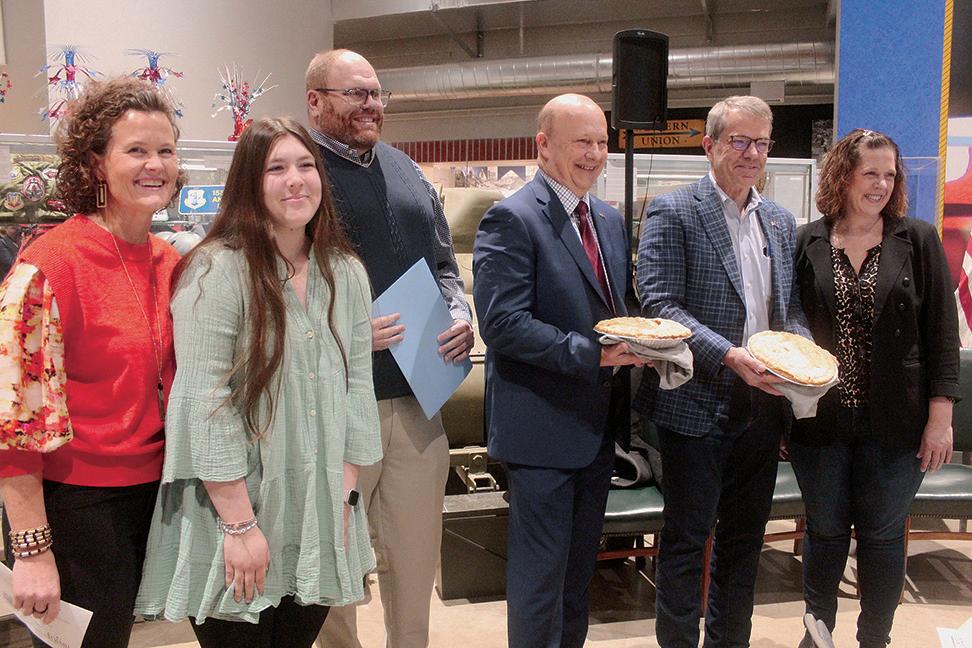
and private contributions to economic development and highlights Seward’s position as one of the top cities in the state for quality of life, according to the NDED.
The community’s award nomination focused on achievements over the past five years including:
• development at the Seward/ Lincoln Regional Rail Campus, a 306-acre industrial park;
• housing and business development, including downtown revitalization efforts and healthcare expansion;
• education improvements including renovated school facilities and investments in career and technical education, wider availability of mental health services for students and new state-of-the-art facilities at Concordia University; and
• bolstered tourism, financial impact through grants, and public and private donations on projects like the Seward Wellness Center and Rural Workforce Housing development.
Among those recognized at the ceremony were Jonathan Jank of the Seward County Chamber and Development Partnership, school leaders, healthcare leaders, business
Attendees couldn’t leave Seward without an apple pie – the recipe served on the Fourth of July. From left, Sen. Jana Hughes, Fourth of July Celebration Youth Chair Julya Metschke, Mayor Josh Eickmeier and (far right) City Council Member Jessica Kolterman present Nebraska Economic Development Director K.C. Belitz and Gov. Jim Pillen with their own apple pies on behalf of the Seward community.
leaders, the city council, and many more.
Eickmeier made a special point to thank city staff for their work in bringing housing and businesses to town.
“Those are the department heads that have to answer the specifics. Do we have the electricity? Do we have the natural gas available? Do we have the other utilities that are expected?” he said. “You can only make good decisions with good information. That’s what we try to always do, be up front and above board, be honest. We don’t want to oversell. We want to deliver. We want to make sure that we can do what we say we’re going to do because our reputation is very important to us as a community.”
Jank thanked the Seward County Visitor’s Bureau, City Administrator Greg Butcher, NDED staff, energy providers, elected officials including Sen. Jana Hughes, and the nearly 300 public and private sector members of the SCCDP, many of whom were involved in the projects related to the nomination.
During the ceremony, Pillen signed a proclamation declaring April “Community Development Month” in Nebraska.
20 NEBRASKA MUNICIPAL REVIEW
Photo provided by Emily Hemphill/Seward County Independent
Reprinted with permission from the Seward County Independent.
Continued from page 18
an energy bill for only three months of the calendar year,” said President of Scratchtown Brewing Company Caleb Pollard.
The energy savings couldn’t have come at a better time for Pollard with the outbreak of the coronavirus pandemic occurring less than a year after installation. “The offset in electrical costs was a godsend during the worst parts of Covid-19 when businesses were closed. In our industry, any cost savings could mean the difference between making it or losing it all,” added Pollard.
In partnership with Cornerstone Bank and the Nebraska Department of Environment and Energy, USDA’s REAP grant helped Pollard make this project more affordable and remain a viable business during a difficult economic time. “Our energy savings alone helped us keep the doors open. Any and all dollars retained during this situation has been imperative to our business’ survival.”
“The impact REAP can have on agricultural operations and rural small businesses is significant,” said Nebraska Energy Coordinator Christopher Faber. “Decreased energy costs or savings realized can be enough to keep the applicant in operation, which has a positive impact on the environment and drives the country toward energy independence. I’d encourage anyone interested in this program to visit our website or give me a call for more information.”
USDA Rural Development has invested nearly $22 million for renewable energy and energy efficient projects in Nebraska since the beginning of 2020. Anyone interested in applying for the REAP program can research area eligibility by visiting the Rural Development website here, or contacting Nebraska Energy Coordinator Christopher Faber, (402) 437-5748, Christopher.faber@usda.gov. Rural Development provides loans and grants to help expand economic opportunities, create jobs, and improve the quality of life for millions of Americans in rural areas. For more info, visit www.rd.usda. gov/ne. To subscribe to USDA Rural Development updates, visit our GovDelivery subscriber page.





21 APRIL 2024 800-383-PUMP www.electricpump.com 402-333-9660 www.mc2h2o.com You can count on us for all your fluid handling and process solutions! An Electric Pump Company
Energy

Ralston bond
rating raised 3 levels
West of the Intersection of 72nd & Main Streets
City now boasts an ‘investment grade’ credit rating; signals to investors that the City is the safest type of investment
Citing strong fiscal management, Standard & Poor raised the City of Ralston’s credit rating from BB+ to BBB+. The three-level increase means the City has earned “investment grade” status—a sign to investors that the City is the safest type of investment.
“The new credit rating is a huge win for Ralston residents,” said Ralston City Administrator Rick Hoppe. “A strong governmental credit rating works like a strong personal credit rating. A strong personal credit rating allows you to buy a house or car at a lower interest rate. The same is true of a city when it borrows money to pay for street or sewer improvements. Lower interest rates save taxpayer dollars.”
Standard & Poor cited Ralston management’s proactive measures to improve its financial position including its demonstrated willingness to reduce its financial vulnerabilities.
Ralston Finance Director Tim Bohling said the pro-active measures cited by Standard included:
• Paying off $9.65 million in debt over the past 3 years;
• Establishing a strong cash reserve;
• Initiating a plan to invest in replacing infrastructure like streets and sewers; and
• Adopting a new investment and debt policy.
“We have conservatively managed
Ralston, Nebraska
our budget and made tough choices over the past several years. A three-level jump in our bond rating is recognition that our emphasis on improving the City’s finances is paying off,” Bohling said.
Issue Date:
“Mayor Don Groesser, the City Council, the City Directors, and especially Finance Director Tim Bohling deserve congratulations for their strong financial leadership. We managed to raise our bond rating while at the same time cutting the city’s property tax levy two cents over the last two years. Ralston’s financial position is very strong,” Hoppe concluded.
December 1, 2023
Deadline for RFP Submissions:
March 1, 2024
Anticipated Developer Selection Date:
April 1, 2024

Anticipated Developer Groundbreaking: Spring/Summer 2025

22 NEBRASKA MUNICIPAL REVIEW
Hinge
Plan MAIN ST 72ND ST RalstonCreek PROPOSALS HINGE 72 REDEVELOPMENT SITE
Source – City of Ralston
Concept
Watch more! KETV produced a story on this big win!
December 2023 The new Ralston City sign.
Photo provided by City of Ralston


Our bankers specialize in:
• Bond Anticipation Notes
• Paving Bonds
• Water and Sewer Bonds
• General Obligation Bonds
• Utility System Revenue Bonds
• Lease-Purchase Financing
Call:
(800) 528-5145 I Paul Grieger
(866) 809-5596 I Cody Wickham
(866) 809-5443 I Andy Forney
(866) 466-9368 I Jerry Spethman

23 APRIL 2024 D.A. Davidson & Co. is committed to strengthening the infrastructure and enriching the lives of people in our communities throughout Nebraska and across the nation.
450 Regency Parkway, Suite 400 Omaha, NE 68114 | (800) 206-7523 D.A. Davidson & Co. member FINRA and SIPC dadavidson.com Building a better future in NEBRASKA with a strong Public Finance Partner
MITIGATING POLICE SHORTAGES IN AMERICA:
A multi-faceted approach that addresses recruitment, retention, training, and community engagement
In recent years, Nebraska, not unlike the rest of the United States, has faced a growing concern: a shortage of police officers. This shortage has become increasingly apparent in communities both big and small, raising critical questions about public safety, law enforcement effectiveness, and the underlying factors contributing to this concerning trend. From cities to villages, police departments are grappling with dwindling numbers of officers, adding to already existing challenges and sparking debates about recruitment, retention, and the complex dynamics shaping law enforcement careers. As communities seek to address this pressing issue, understanding the root causes and potential solutions is critical to ensuring the safety and well-being of citizens.
Here are some ideas:
1. RECRUITMENT STRATEGIES

 DAVE BOS EXECUTIVE DIRECTOR, LARM
DAVE BOS EXECUTIVE DIRECTOR, LARM
• Increase outreach efforts. Target all populations with a goal of maintaining diversification within the police force.
• Offer incentives such as signing bonuses or tuition reimbursement to attract qualified candidates.
• Streamline the hiring process to make it more efficient and appealing to potential recruits.

2. RETENTION PROGRAMS
• Implement retention bonuses, salary increases, or shift selection bidding to incentivize experienced officers to stay in their positions.
• Provide opportunities for career advancement, professional development, and specialized training to keep officers engaged and motivated.
• Enhance workplace support systems, including mental health resources and peer support programs, to address the stress and challenges of police work.
3. COMMUNITY POLICING INITIATIVES
• Invest in community policing programs that prioritize building positive relationships between law enforcement and the communities they serve.
• Establish partnerships with community organizations, schools, and local businesses to address underlying social issues and prevent crime collaboratively.
• Implement procedural justice training for officers to promote fairness, transparency, and respectful interactions with the public.
Continued on page 26 / See Police
24 NEBRASKA MUNICIPAL REVIEW
A Norfolk cop visits with a community member at National Night Out in 2021. Photo provided by LARM.

25 APRIL 2024
Continued from page 24
More ideas:
4. TECHNOLOGY AND INNOVATION
• Deploy technology solutions such as body cameras, dash cameras, and data analytics to improve transparency, accountability, and efficiency in law enforcement operations.
• Invest in predictive policing technologies to allocate resources effectively and prevent crime proactively.
• Explore alternative policing models, such as the use of civilian community resource officers for non-emergency tasks, to alleviate the workload on sworn officers.
6. COLLABORATION AND COORDINATION
• Foster collaboration among federal, state, and local law enforcement agencies to share resources, best practices, and intelligence.
• Partner with academic institutions and advocacy groups to conduct research and evaluation on effective policing strategies.
• Engage with policymakers, community leaders, and citizens to develop evidence-based solutions tailored to the specific needs of each community.
Although this issue may never completely go away, by implementing these strategies in a coordinated and comprehensive manner, policymakers, law enforcement agencies, and citizens can work together to mitigate police shortages and build safer, more resilient communities.
5. ADDRESSING SYSTEMIC ISSUES
• Address systemic issues within law enforcement agencies, including bias, discrimination, and excessive use of force, through comprehensive reform efforts.
• Implement policies and training programs focused on de-escalation techniques, cultural competency, and implicit bias awareness.
• Strengthen accountability mechanisms, including civilian oversight boards and independent review processes, to ensure transparency and accountability in policing practices.

Engineering a world where everyone thrives.

Engineering | Architecture | Surveying | Planning jeo.com
26 NEBRASKA MUNICIPAL REVIEW Police
DED accepting applications for grant opportunity within the Site and Building Development Fund
The Nebraska Department of Economic Development (DED) is now accepting applications for a specific grant opportunity through the Site and Building Development Fund (SBDF). The opportunity is open to a city of the first class located in the third congressional district if the property previously housed a university or college that is no longer extant. The improvement and revitalization of the real property must be for purposes of supporting the housing, employment, and program needs of youth exiting the foster care system. In addition, the real property may be used for youth exiting juvenile court supervision in an out-of-home placement.
Established in 2011, SBDF helps Nebraska’s communities prepare the places and spaces needed to support business growth. Having industry-ready facilities strengthens recruitment and retention of high-wage job creators. SBDF gives communities a competitive advantage when seeking to attract investment—whether from a new venture or existing company looking to expand.
Described in Nebraska Revised Statute §8112,147(1)(j), this particular funding opportunity is known as the SBDF: Subdivision (1)(j) of Section 81-12,147 Grant. It was created by the Nebraska Legislature as part of Legislative Bill (LB) 818 in 2023 and updated by LB 1413 in 2024.
The application is now open. The last day to submit an application for the SBDF: Subdivision (1)(j) of Section 81-12,147 Grant is Wednesday, May 15, 2024, at 5:00 p.m. CT. Applications must be submitted electronically through AmpliFund, DED’s grant management system, before the application due date. Applicants may request the application link from Business Project Manager, Lorena Reichert, at lorena.reichert@nebraska.gov.
For additional information, please contact Business Project Manager Lorena Reichert at lorena.reichert@ nebraska.gov or 402-314-6468.
Source – Nebraska Dept. of Economic Development
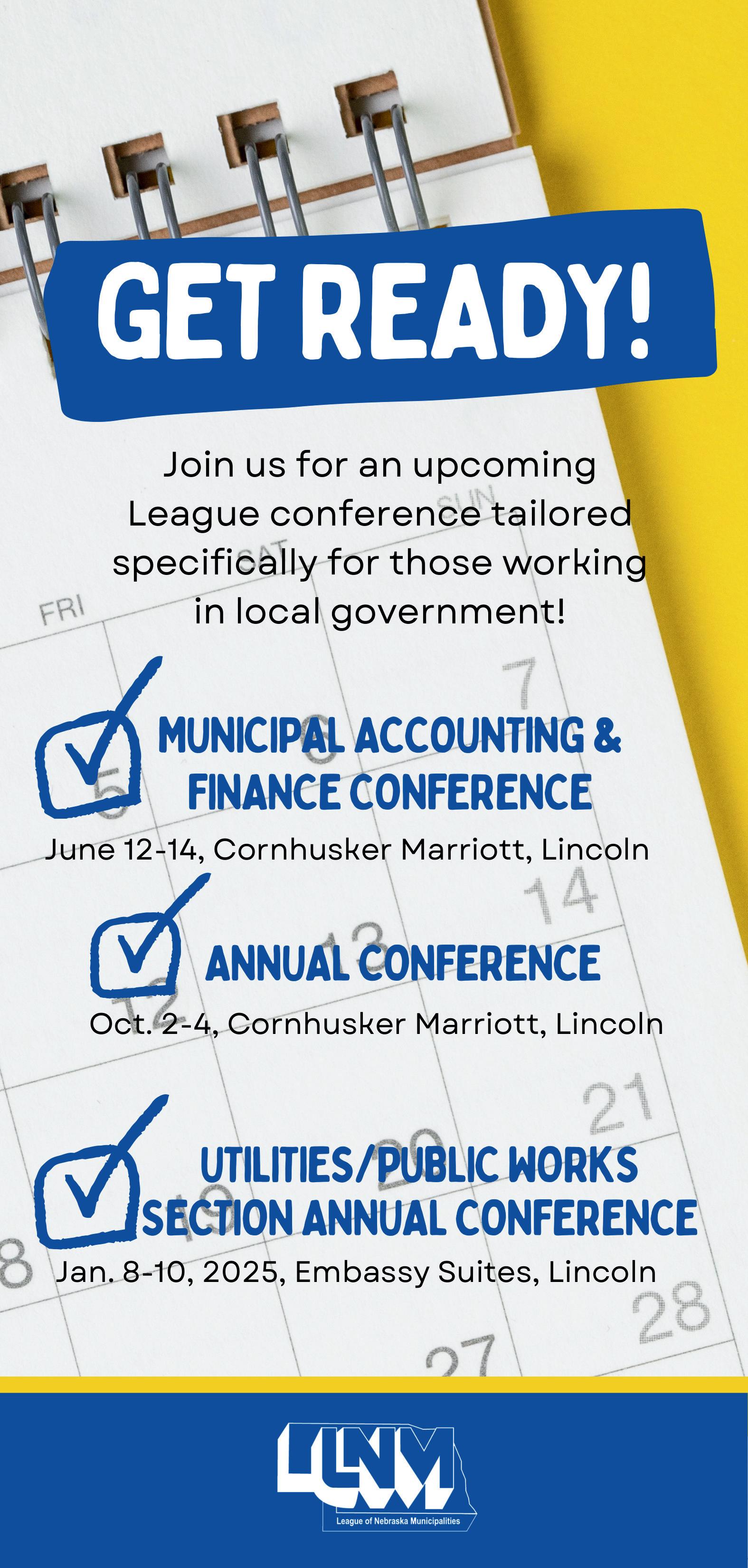
27 APRIL 2024
 Andy Barry
Andy Barry
OPublic records in Nebraska
n March 15, 2024, the Nebraska Supreme Court decided an important case on public records.
In its decision, Nebraska Journalism Trust, d/b/a Flatwater Free Press v. Nebraska Department of Environment and Energy, 316 Neb. 174 (2024), the court held that a public body may charge for the time non-attorneys spend reviewing records to determine if they are exempt from public disclosure. However, on March 21, the Legislature unanimously passed LB 43, which undid that portion of the court’s ruling. Understanding the decision and LB 43 will be important to complying with public records statutes going forward. The circumstances of the case also suggest grounds for further study and consideration by municipalities. Flatwater Free Press has been reporting and publishing articles on nitrates leeching into Nebraska groundwater from the use of chemical fertilizers, as well as possible links between nitrates and brain cancer. As part of its reporting, Flatwater asked the Department of Environment and Energy for emails sent to or received from Natural Resource Districts over a period of 12 years with the keywords “nitrate,” “nutrient,” “fertilizer,” and “nitrogen.” The Department’s records manager said it would cost $2,000 to gather the records. Flatwater then narrowed the timeframe of the request to seven years but asked for all emails within certain divisions of the agency, regardless of whether they were sent to or received from an NRD. It isn’t clear whether the number of responsive emails went up or down, but the Department’s cost estimate increased by 2200% to over $44,000. The Department said 102 employees and a records supervisor would need to review the emails to see if they could be withheld.
The Department refused to begin searching for records until
BY ANDY BARRY, CLINE WILLIAMS WRIGHT JOHNSON & OLDFATHER, L.L.P.
after Flatwater paid the $44,000 deposit. Flatwater sued to challenge the Department’s refusal.
Two important issues were decided by the Nebraska Supreme Court. First, the court held that a party may file an action seeking a writ of mandamus to challenge a cost estimate. Second, the court held that, even though the relevant statute, Neb. Rev. Stat. § 84-712, forbids public bodies from charging for time attorneys spend reviewing records to see if there is a legal basis to withhold them, it allows an agency to charge for the time non-attorneys spend reviewing records with a view to withholding them from public view.
Within a week after the decision, the Nebraska Legislature acted unanimously to undo the second part of the court’s holding. In LB 43, the Legislature amended § 84-712 to provide that a public body may not charge for time any person spends to determine whether a record may be withheld when the record is requested by a resident of Nebraska. For requests made by Nebraska residents, the Legislature also changed the statute to increase from four to eight the amount of time for which a public body may not charge to search for public records.
Under LB 43, the rules are now different for nonresidents. In the case of a request by a non-resident, a public body may include a charge based on the existing salary or pay obligation of public officers or employees, including a charge for the services of an attorney to search, identify, redact, copy, or review records in response to a public records request. The public body may waive or reduce the fee if it is in the public interest to do so.
As a result of the new law, it is now important to know whether the person making a request is a resident or a
28 NEBRASKA MUNICIPAL REVIEW
THE LEGAL CORNER
“Government exists to serve the public interest, and the public have an interest in knowing what their government is up to. The ‘public’ also includes local governments and their citizens who are governed by state agencies."
Cline
non-resident of Nebraska. The new statute provides that a resident means a person domiciled in Nebraska. It also provides that “resident” includes news media without regard to domicile. If responding to a public records request is likely to involve significant time to review documents, it will be useful to ask whether the request is being made by a member of the news media or a person who lives in Nebraska.
Flatwater Free Press raises important policy issues about government transparency and the costs and administrative burdens of providing that transparency. Several organizations, including the League, submitted friend-of-the-court briefs addressing those issues. In its decision, the Nebraska Supreme Court held that its role was not to resolve questions of policy but to apply the plain language of the statute. Those policy issues, however, remain even after the Legislature’s enactment of LB 43.
As the attorneys and the court noted during oral argument, Nebraska’s public records statutes date back to before statehood. Portions of the statute still reflect the idea that a citizen could walk into an office, be given access to a cabinet, and find the relevant records. The growing and in some instances near total use of computers makes that concept increasingly obsolete in terms of how records are generated, requested, accessed, and provided. On the one hand, it is simple to request records containing keywords. For example,
-Andy Barry, Partner
Williams Wright Johnson & Oldfather
a requester could ask for all emails that contain a specific word, such as “development” or “water.” It is easy to make many requests and requests that are extremely broad. If a public body is not concerned about privilege or other grounds for withholding the records, it is also relatively simple to provide them. On the other hand, the ease with which records can be requested threatens to impose heavy burdens on public bodies, particularly local governments with scarce personnel and financial resources, even when grounds for withholding the records are not at issue.
Several policy changes could be considered to address these issues. First, in litigation, courts frequently employ principles of proportionality to limit the time frame of requests or the scope of records that must be provided. Amending the public records statutes to require or encourage proportionality could help reduce the burden of responding to requests.
Second, governments already make many records available to the public automatically through the internet. Making additional records available in this manner would increase transparency and decrease the time and expense of responding to requests. Such automatic transparency would obviously need to be balanced against legitimate reasons for withholding certain types of records.
It's worth noting that transparency isn’t necessarily the enemy of government. Government exists to
serve the public interest, and the public have an interest in knowing what their government is up to. The “public” also includes local governments and their citizens who are governed by state agencies. Nebraska’s cities and villages and the people who live in them have an interest in knowing whether state government is doing its job—in this case, the work of ensuring that water is safe to drink.
Time will tell whether LB 43 creates substantial new burdens that compromise the ability of local governments to do their own work. If those burdens materialize, local governments will have an interest in encouraging the Legislature to alleviate them, but not at the expense of transparency. In the words of Syracuse native Hartley Burr Alexander, which are etched into our Capitol, The Salvation of the State is Watchfulness in the Citizen.
Editor’s Note: The views expressed by the author are not necessarily those of the editor. This article is not intended to provide legal advice to its readers. Rather, this article is intended to alert readers to new and developing issues. Readers are urged to consult their own legal counsel or the author of this article if they wish to obtain a specific legal opinion regarding their particular circumstances. The author of this article, Andy Barry, can be contacted at Cline Williams Wright Johnson & Oldfather, L.L.P., 233 South 13th St, 1900 US Bank Bldg., Lincoln, NE 68508, abarry@clinewilliams.com or www.clinewilliams.com. 486
29 APRIL 2024
Center for Rural Affairs develops Nebraska Rural Farmers Market Handbook
Are you considering implementing a farmers market in your community? Do you want to improve the outreach of an existing farmers market?
The Nebraska Farmers Market Manager Handbook brings together ideas, inspiration, and insight from farmers markets across Nebraska. It is the culmination of research, hands-on experience, and interviews with market managers, vendors, and professionals. Download this toolkit for advice and inspiration from Nebraska's farmers markets.
Markets began as a way to do business, but have evolved into a way to connect people with their communities, food producers, and the land that surrounds them.
Source – Center for Rural Affairs

PROFESSIONAL DIRECTORY






30 NEBRASKA MUNICIPAL REVIEW Financial & Single Audits Budget Consulting & Preparation Retirement Plans Benchmarking & Rate Studies Contact Marcy Luth, Michael Hoback Joe Stump, Kyle Overturf or Tracy Cannon 1203 W. 2nd Street Grand Island, NE 68801 Ph 308.381.1810 Fax 308.381.4824 www.gicpas.com ENGINEERING ARCHITECTURE CONSTRUCTION FIELD SERVICES Omaha - 402.493.4800 | Lincoln - 402.488.2500 SCHEMMER.COM MUNICIPAL CODE SERVICES, INC. MUNICIPAL CODE REVISION BASIC CODE FOR SMALL VILLAGES UPDATING FOR AMERICAN LEGAL AND OTHER CODES UPDATING FOR ZONING REGULATIONS POLICY MANUALS Personal Service / Nebraska Company P.O. Box 164, Neligh, NE 68756 Phone 402.887.5022 leagle@mcnallylaw.net www.mcodeservices.com
Resource alert:
the guide here!
Access
Ask LNM F requently A sked Q uestions municipal

After the presentation at the Midwinter Conference entitled “Top 10 Questions with No Clear Answer in State Law,” the League has received several phone calls regarding the difference between minutes and official proceedings. Below are some of the questions the League has received and our answers. As always, you should contact your municipal attorney about these issues if you have further questions. This article is not intended as legal advice.
Topic: Minutes and official proceedings
Do the official proceedings of meetings need to be published in a newspaper?
Yes. Under section 19-1102, all municipalities having a population of not more than 100,000 inhabitants are required to publish the official proceedings of the city council or village board within 30 days after any meeting. The publication needs to be in a newspaper in or of general circulation in the village or city and set
Do minutes need to be published in the newspaper?
No. According to the Open Meetings Act, minutes do not need to be published in the newspaper. Section 84-1413 of the Open Meetings Act includes several requirements about minutes including the requirement that municipalities keep minutes of all meetings showing the time, place, members present
forth a statement of the proceedings of the meeting. The official proceedings also include the amount of each claim allowed, the purpose of the claim, and the name of the claimant, except that the aggregate amount of all payroll claims may be included as one item. and absent, and the substance of all matters discussed. The minutes are public records and must be available for inspection within 10 working days or prior to the next convened meeting, whichever occurs earlier. Minutes may be kept in written or electronic form. But the Open Meetings Act does not require minutes be published in the newspaper.
What about the publication of minutes on the city’s website?
Omaha, Lincoln, and cities of the first class are required to make available on their public website the agenda and minutes of any meeting of the city council. The agenda needs to be placed on
the website at least 24 hours before the meeting of the city council. Minutes need to be placed on the website at such time as the minutes are available for public inspection and need to stay on the website for at least six months.
What is the difference between minutes and official proceedings?
Generally, official proceedings are not as detailed as minutes. Several years ago, the League and the Nebraska Press Association negotiated the term “official proceedings” and determined they need to include three things:
1. A summary of each agenda item;
2. A summary of each motion including ordinances
and resolutions and the result of the vote; and
3. An indication of how the members voted on each motion.
Minutes may contain more information than what is required in official proceedings. For example, minutes may include items such as reports from city officials, old business, and new business.
If you have further questions regarding publication requirements, please reach out to your municipal attorney.
31 APRIL 2024
LNM
LNM LNM LNM
BURBACH AQUATICS, INC.

Is your pool ready for summer?
Did your pool leak last swim season?
High Water Bill?
Excessive Chemical Use?
Dropping Water Levels?
Then you need to give Burbach Aquatics, Inc. a call.
Pool leaks are problematic and ignoring them creates much bigger problems. Especially when water is being purchased, treated, and heated, the financial loss increases rapidly.
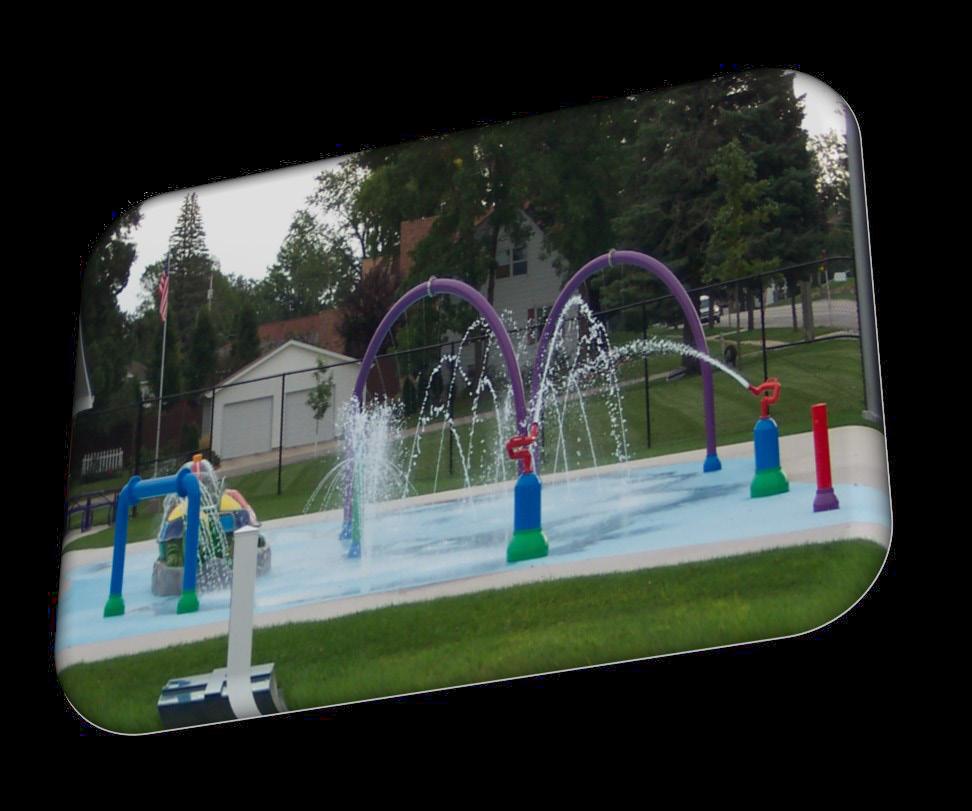



32 NEBRASKA MUNICIPAL REVIEW burbachaquatics.com Burbach Aquatics, Inc. 5974 State Highway 80 South Platteville, Wisconsin 53818 Phone: 608-348-3262 Fax: 608-348-4970 Email: Support@Burbachinc.com
PROVEN RELIABILITY IN AQUATIC DESIGN FOR OVER 45 YEARS!!
© 2024 BURBACH AQUATICS, INC.


 McCook
Ogallala
McCook
Ogallala




 BY EMILY HEMPHILL SEWARD COUNTY INDEPENDENT
BY EMILY HEMPHILL SEWARD COUNTY INDEPENDENT











































 DAVE BOS EXECUTIVE DIRECTOR, LARM
DAVE BOS EXECUTIVE DIRECTOR, LARM




 Andy Barry
Andy Barry












